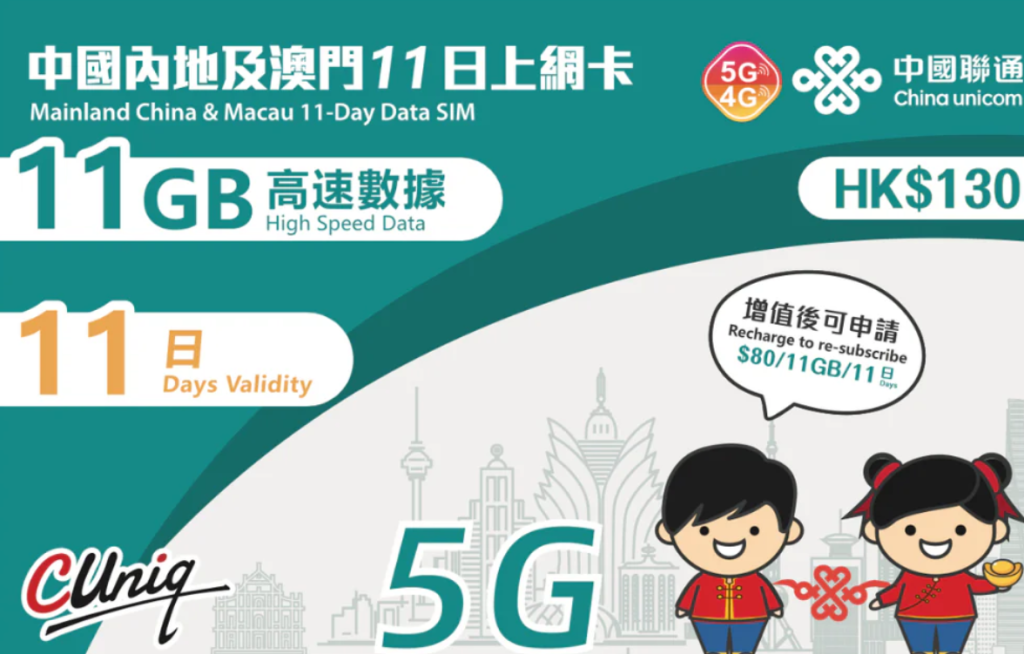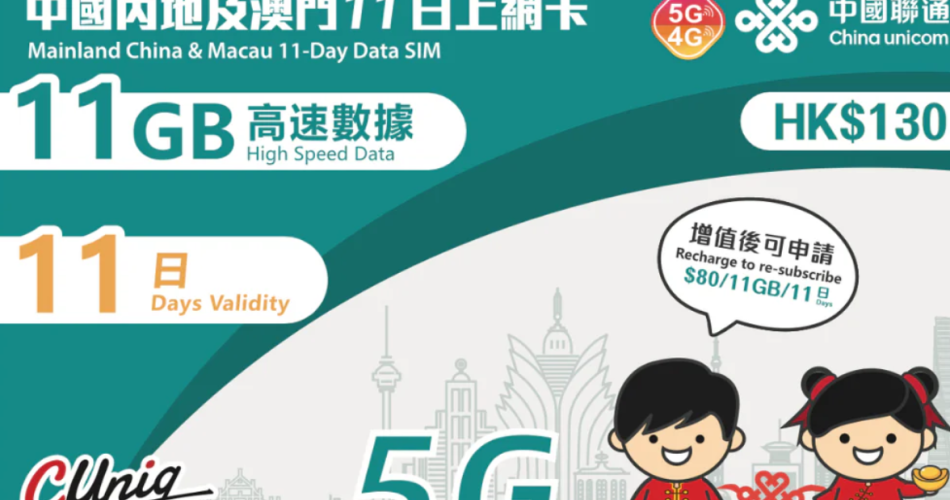In today’s digital age, staying connected has become essential for both business travelers and tourists alike. When crossing borders between Mainland China and Macau, maintaining seamless internet access can be challenging. After extensive research and personal experience, I’ve discovered an efficient solution – the China Unicom Mainland China & Macau 5G/4G 11GB Pure Data 11-Day Roaming SIM Card. This comprehensive review details my experience using this connectivity solution during a recent cross-border business trip.
The Challenge of Cross-Border Connectivity
For frequent travelers between Mainland China and Macau, maintaining consistent internet access often means juggling multiple SIM cards or paying excessive international roaming charges. The administrative regions have different telecommunications networks, creating a digital border that can be as frustrating as the physical one. Finding a single solution that works efficiently across both territories can save time, money, and considerable frustration.
Discovering the Perfect Solution
While preparing for my recent business trip that would take me from Macau to several mainland Chinese cities, I was determined to find a better connectivity solution than my previous experiences of either paying premium roaming fees or constantly swapping local SIM cards.
A colleague who frequently travels this route recommended China Unicom’s specialized cross-border data SIM. The proposition seemed ideal: 11GB of data valid for 11 days, usable across both Mainland China and Macau, with 5G capability where available. Most importantly, it promised a truly seamless experience without requiring any configuration changes when crossing between regions.

First Impressions and Activation
The SIM card came in professional packaging with clear instructions in multiple languages. Activation was refreshingly straightforward—simply insert the card, enable data roaming in your phone settings, and you’re connected. There’s no registration requirement, making it particularly convenient for international visitors who may not have Chinese identification documents.
What impressed me immediately was the absence of the usual activation hurdles. Unlike many local Chinese SIM cards, this one requires no real-name registration, saving valuable time and paperwork. The APN settings (3gnet) were automatically configured on my smartphone, eliminating the technical setup that often frustrates less tech-savvy travelers.
Performance in Macau
Landing at Macau International Airport provided the first test of the SIM card’s capabilities. Within seconds of turning on my phone, the 5G signal appeared at full strength. I was immediately able to use ride-sharing apps, message family about my safe arrival, and check my hotel reservation details—all without hunting for airport WiFi or waiting in line at a telecom counter.
During my two-day conference in Macau, the connection remained consistently strong, even in the basement levels of the convention center where WiFi signals struggled to penetrate. Download speeds averaged 150-200Mbps in most urban areas, enabling smooth video calls and quick access to cloud-based presentation materials.
Seamless Transition to Mainland China
The true test came when crossing from Macau to Zhuhai via the Hong Kong-Zhuhai-Macau Bridge. Previous experiences with other SIM cards had taught me to expect a frustrating period of network searching and reconfiguration when entering Mainland China.
With this SIM card, however, the network transition was virtually imperceptible. As soon as we cleared customs, my phone connected to China Unicom’s mainland network without requiring any manual intervention. This seamless handover between networks saved valuable time and eliminated the connectivity anxiety that often accompanies border crossings.
Business Reliability Across Multiple Chinese Cities
My itinerary included visits to Guangzhou, Shenzhen, and Shanghai—each presenting different network environments. Throughout these urban centers, the 5G connection remained consistent and reliable. Even during high-speed train journeys between cities, the network maintained usable speeds, allowing me to prepare for meetings and respond to emails productively while traveling.
Particularly notable was the connection stability in crowded business districts. During peak hours in Shenzhen’s technology hub, where thousands of professionals simultaneously use mobile data, the connection remained strong with minimal speed fluctuations—a testament to China Unicom’s robust network infrastructure.
Beyond Basic Connectivity: Additional Features
The SIM card offers several valuable features beyond simple internet access:
- Mobile Hotspot Support: The ability to share data with laptops and tablets eliminated the need to purchase separate WiFi devices or connect to potentially unsecured public networks.
- Full Application Compatibility: All major international services functioned perfectly, including Google services, WhatsApp, Facebook, and WeChat—essential tools for maintaining both business and personal connections.
- VoIP Calling Capability: While the SIM doesn’t provide traditional voice service, it fully supports internet-based calling through WhatsApp and WeChat, which proved more than sufficient for all communication needs.
Data Sufficiency: Is 11GB Enough?
Before the trip, I questioned whether 11GB would be sufficient for an 11-day business journey. In practice, it proved more than adequate. Daily usage for emails, navigation, social media, and occasional video calls averaged around 700MB per day. By implementing simple conservation practices like downloading maps for offline use and connecting to hotel WiFi when available, I completed the entire trip using only about 7.5GB of the allocated data.
For reference, here’s approximately how much data typical activities consumed:
- Google Maps navigation: ~40MB per hour
- Video calls: ~250MB per hour
- HD video streaming: ~700MB per hour
- Web browsing and emails: ~15MB per hour
- Social media with photos: ~80MB per hour
Limitations to Consider
No connectivity solution is without drawbacks. The primary limitations of this SIM card include:
- No Traditional Voice Calling: While internet-based calling worked excellently, the inability to make or receive traditional phone calls could be problematic in emergency situations where internet connectivity isn’t available.
- Fixed Data Allocation: Once the 11GB limit is reached, data service stops completely. There’s no option to purchase additional data, which requires careful management for longer or data-intensive trips.
- Expiration Timeline: The 11-day validity begins immediately upon first use, so timing the activation to coincide with your itinerary is crucial for maximizing value.
Cost-Effectiveness Analysis
When comparing costs with alternatives, this SIM card presents compelling value. International roaming with home carriers typically costs $10-15 per day, potentially exceeding $150 for an 11-day trip. Purchasing separate SIM cards for Macau and Mainland China would cost approximately $20-30 each, plus the inconvenience of swapping cards and managing multiple phone numbers.
At approximately $25-30 (depending on retailer), this unified solution offers significant savings while eliminating the administrative hassle of managing multiple connectivity solutions.
Tips for Optimal User Experience
Based on my experience, here are recommendations for getting the most from this SIM card:
- Verify Device Compatibility: Ensure your smartphone is unlocked and supports the 5G/4G bands used in China and Macau before purchase.
- Enable Data Roaming: Remember to activate this setting in your phone before inserting the SIM card.
- Monitor Usage: Install a data tracking app to keep tabs on consumption and avoid unexpectedly reaching limits.
- Strategic Activation: Since the 11-day countdown begins upon first use, activate the SIM only when you truly need it.
- Offline Content: Download maps, translation data, and entertainment content when connected to WiFi to conserve mobile data.
- Long-term Planning: With an activation deadline of June 30, 2026, frequent travelers can purchase multiple cards in advance without worrying about imminent expiration.
Conclusion: A Reliable Bridge Between Territories
After 11 days of intensive testing across multiple scenarios and locations, the China Unicom Mainland China & Macau 11GB data SIM proved to be an exceptional connectivity solution for cross-border travel. Its primary advantages—seamless network transitions, robust 5G performance, and freedom from registration requirements—address the key pain points that travelers typically face when navigating these regions.
For business travelers and tourists alike, this SIM card represents more than just a data connection; it’s a digital passport that eliminates connectivity borders between Mainland China and Macau. The convenience of maintaining a single, reliable internet connection throughout both territories transforms the travel experience, allowing you to focus on your journey rather than your connectivity challenges.
Whether you’re attending business meetings in Shenzhen, exploring the historic streets of Macau, or traveling between these fascinating regions, this specialized SIM card delivers the consistent connectivity essential for today’s digital traveler.
Note: This review is based on personal experience using the China Unicom Mainland China & Macau 5G/4G 11GB Pure Data 11-Day Roaming SIM Card during a business trip in April 2025. Network conditions and coverage may vary based on location and time of year.
